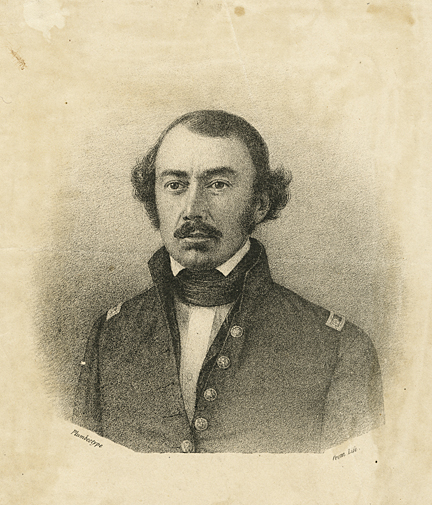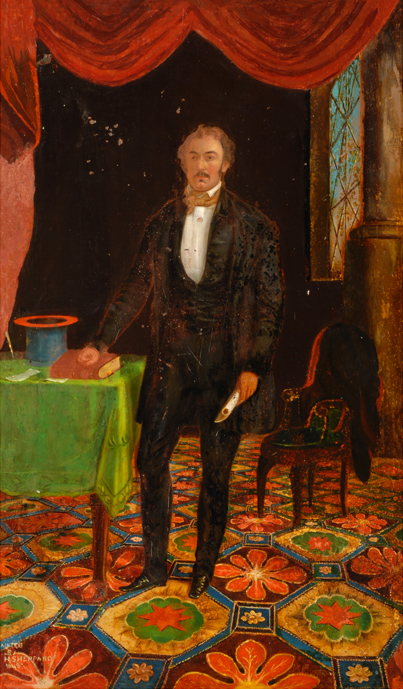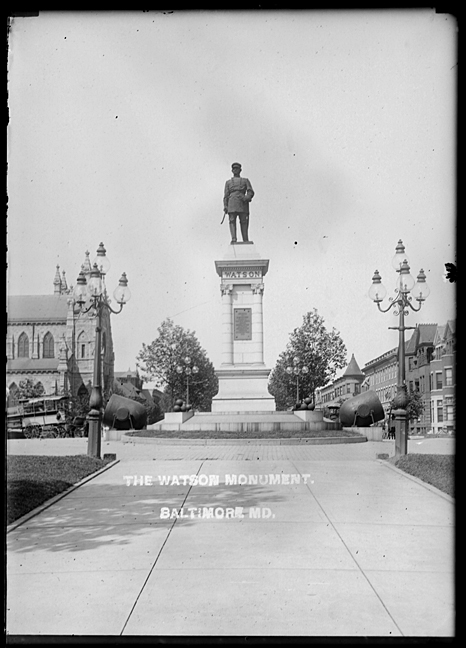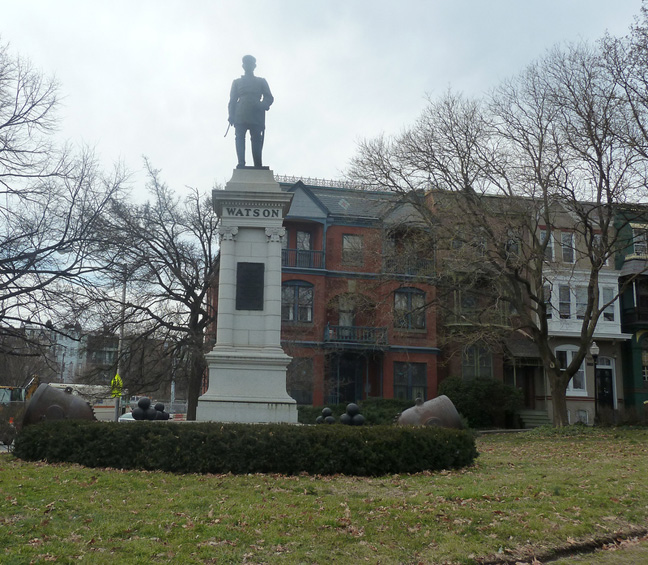“To die is gain”: Memory and the U.S.-Mexican War in Maryland

The Watson Monument created by sculptor Edward Berge is flanked by captured Mexican mortars. Corpus Christi Church can be seen in the background here at its original location at Lanvale Street and Mount Royal Avenue. In 1930, the monument was moved to Reservoir Hill—what was then the entrance to Druid Hill Park—because of a planned extension of Howard Street. This photo shows what is now an underpass that engineers felt would not have held the weight of the monument. William Watson Monument, ca. 1906, MdHS, MC2484.
On an auspicious afternoon in late September 1903, a crowd of Baltimoreans converged onto the intersection of Mount Royal Avenue and Lanvale Street to witness the symbolic-laced unveiling of the William H. Watson monument. The monument, erected by the Maryland Association of Veterans of the Mexican War, honored Marylanders who lost their lives during the U.S.-Mexican War.(1) Taking place on the fifty-seventh anniversary of Lieutenant Colonel Watson’s death during the Battle of Monterey, spectators watched as aged survivors of the war took their places on the grandstand. Meanwhile, they also laid eyes on the over ten-foot statue, draped in the flag that had shrouded Watson’s corpse as it left Mexico. The most symbolic moment came when Watson’s last surviving child, Monterey Watson Iglehart, walked towards her father’s likeness and unveiled the statue. The unveiling by Iglehart, born on the day her father died, was the highlight of a ceremony that included speeches from U.S.-Mexican War veterans, politicians, and other dignitaries.(2)
“[E]nduring object lessons”
The unveiling partly served as an opportunity to describe the bravery of Marylanders who fought in Mexico. At the same time, it also provided an opportunity for dignitaries to discuss the monument’s impact on public memory. In presenting the Watson Monument to the city of Baltimore, Louis F. Beeler, president of the Maryland Association of Veterans of the Mexican-American War, talked about the proud record of the state’s war veterans. He also talked about how the monument, finally realized after fifty years of planning, served to honor all the Marylanders who died fighting for their country.(3) Among all the speakers, Edwin Warfield, president of the Fidelity and Deposit Company of Maryland, spoke most clearly of the monument’s long-term role in shaping public memory. Warfield believed that “[m]onuments are enduring object lessons, pointing the rising generations to the services of their fathers, and pressing home to their minds great events and epochs in the history of our country.”(4)
The Watson Monument recognized the importance surrounding the U.S.-Mexican War experience, while simultaneously interpreting the past in an effort to shape the present.(5) By highlighting the valor and honor of Baltimore’s U.S.-Mexican War heroes, like Watson and Brevet Major Samuel Ringgold, the Maryland Association of Veterans of the Mexican War allowed the public to view the veterans as heroes of a conflict which greatly benefited the United States, as opposed to participants in an unjustifiable land grab. Watson and Ringgold’s deeds illustrated the sacrifices that came with the United States’s mission of spreading democracy. The monument thus provided “enduring object lessons” that enabled Baltimoreans to shape contemporary circumstances. Given the theoretical similarities between the U.S.-Mexican War and the United States’s imperialist endeavors of the late-nineteenth and early-twentieth centuries, the monument offered implicit support to national endeavors in the Caribbean.
“The bands which unite our country…”
Today, the monument blends into the scenery of west Baltimore. The war that it commemorates has faded from memory, especially on the East Coast.
Tensions between Mexico and the United States, which had brewed for years, boiled over after James Polk was elected president in 1844, with a promise to annex Texas. Texas was then an independent republic, having broken away from Mexico in 1836. Mexico did not recognize Texas independence, considering it instead a rebel province, much like China considers Taiwan today. Worse, even if Mexico was willing to negotiate away its claim to Texas, a border dispute existed. Texas claimed the boundary at the Rio Grande. Mexico claimed the traditional boundary, the Nueces River, 100 miles north.
When it became clear that Texas would enter the United States, President Polk sent General Zachary Taylor with an army to the edge of the disputed zone. Then in early 1846, Taylor’s army advanced to the Rio Grande. Meanwhile, Mexican troops crossed the Rio Grande. Since both armies were in the disputed zone, both could claim that blood had been shed by the other in its own territory when hostilities broke out at Palo Alto and Resaca de la Palma on April 25, 1846. When word of the fighting reached Washington, President Polk immediately asked Congress for a declaration of war, stating that Mexico had “shed American blood on American soil.” Mexican president Mariano Paredes could make a similar claim. Congress complied, and declared war.(6)
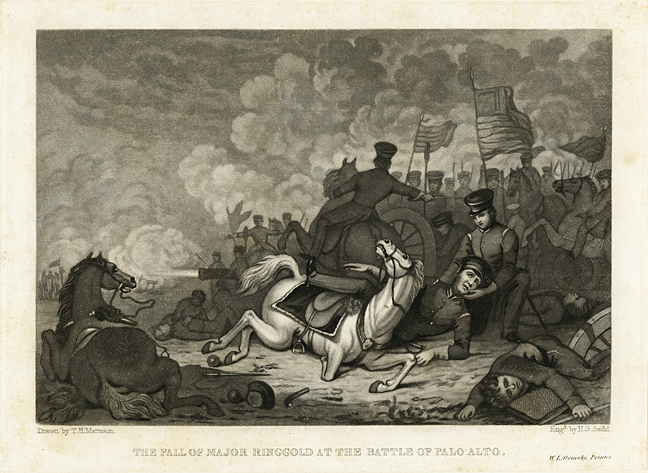
“The Fall of Major Ringgold at the Battle of Palo Alto,” drawn by T.H. Matteson, engraved by H.S. Sadd, MdHS, Small Prints.
Brevet Major Samuel Ringgold became the first prominent Marylander to die during the war. During the Battle of Palo Alto, Ringgold became mortally wounded when he had both thighs “torn out” by a Mexican cannon ball. He died on May 11, 1846, in Port Isabel, Texas.(7) Ringgold’s death muted the joy Baltimoreans felt in the aftermath of General Taylor’s victories. Flags throughout the city flew at half-staff, as did all the flags that adorned the ships in the Baltimore Harbor. Buildings within the city were draped with black crepes. Poignantly, the Baltimore Sun noted that Ringgold’s “fate so sad, his fame so brilliant, has awakened a lively interest in all that relates to him, especially in this city, where it is now apparent that he was known only to be loved, and where his memory will continue to be affectionately revered.”(8)
For the next year and a half, Mexican and U.S. armies battled across Mexico. After Resaca de la Palma and Palo Alto, Taylor’s armies advanced through northern Mexico. The Battle of Monterey, fought on September 21-24, 1846, came at a cost of losing Lieutenant Colonel William H. Watson. During fierce street fighting, Watson had his horse shot out from under him. He rose, and, while trying to lead his troops in an attack against Mexican forces, he received a musket shot to the neck which killed him instantly. According to Charles J. Wells, Watson’s death represented “one of the great tragedies of the day for the Baltimoreans.”(9)
Watson died instantly, but his stature grew as stories surrounding his death emerged. According to historian Robert W. Johannsen, “[t]he dying moments of fallen soldiers were told and retold in the war’s literature, and their last words were offered as evidence of the patriotic ardor of the men in Mexico.”(10) Watson, already wounded, had been urged to retreat. He refused, stating that, “[n]ever will I yield an inch! I have too much Irish blood in me to give up!”(11)
The war was not without opposition. Senator James Pearce of Maryland, for example, questioned President Polk’s motives, and believed that the United States could not rule over such a large expanse of land: “[t]he bands which unite our country, if stretched so far, must inevitably snap.”(12)
But opposition to the war faded as General Winfield Scott’s army moved from Vera Cruz to Mexico City in 1847, occupying the “halls of the Montezumas” in September. The Treaty of Guadalupe Hidalgo, signed on February 2, 1848, ended the war, with Mexico ceding the northern portions of its territory to the United States for $15 million.(13)
The war had a significant impact on the United States. In addition to the United States gaining a quarter of its continental footprint—all or parts of the states of Texas, New Mexico, Arizona, California, Nevada, Utah, Wyoming, Oklahoma, and Kansas—that conflict provided the final tinders for an issue that would ignite into civil war scarcely a decade later: slavery.(14)
Over time, the memory of the war’s controversy faded, and Marylanders, like people in the rest of the United States, united to commemorate the conflict and its veterans.
“To die is gain”
Death catapulted Marylanders like Ringgold and Watson into the realm of American heroes. The U.S.-Mexican War, according to Johannsen, led to the appearance of a new group of individuals who would help the nation “celebrate deeds of courage, daring, and leadership.” For U.S. soldiers, one of the quickest ways to achieve hero status was through death on the battlefield.(15) Ringgold had already been considered a hero before Americans, and Marylanders, received word of his death. In death, Ringgold reached the highest stage on the scale of heroism. He became a “true Chevalier ‘sans peur, sans reproche,’—the Bayard of our army.”(16)
Similarly, death enabled Watson to achieve the status of an American hero. Reverend Henry V.D. Johns, D.D., stated that “[t]o die is gain.” As Reverend Johns declared in a sermon to honor Watson, G. A. Herring, and J. Wilker, Johns continued, “[n]o earthly honor, my brethren, can be placed upon the summit of that glory, which common consent of all ages and nations, is assigned to those who die in the lawful service of their country; and for this reason—that no arm of mortal can reach that elevated point.”(17) Ringgold and Watson’s heroism helped define the way Marylanders would remember the U.S.-Mexican War.
Maryland’s U.S.-Mexican War veterans returned home and formed the Association of Maryland Volunteers in the Mexican War by 1849. In forming the veterans’ association, the veterans were “desirous of perpetuating the recollection of their services and the memory of their deceased comrades.” The group imposed fines or recommended expulsion for members who failed to comply to the organization’s rules of acceptable behavior.(18) Furthermore, the association also relied on symbolic imagery to achieve the objective of preserving positive memories of the U.S.-Mexican War, relying on images that reminded people of the heroism of its members. For instance, during the eighth anniversary of the Battle of Monterey, John R. Kenly received “a gold ring enclosing a miniature of Col. Wm H. Watson, by the Servicemen of the Baltimore Battalion and DC and MD Regiment in war with Mexico.” Watson’s image probably did not need much explanation for people living in Baltimore in 1854.(19)
The association’s efforts received a boost from an important piece of poetry written during the Civil War. After the Sixth Massachusetts Regiment fired on a mob of Baltimoreans in April 1861, James Ryder Randall penned a poem that condemned the North, urging Marylanders to stand up and repel the invaders. Titled, “Maryland, My Maryland,” the poem referenced several of the state’s prominent historical figures, including Ringgold and Watson. Randall wrote, “With Ringgold’s spirit for the fray,/With Watson’s blood at Monterey . . ./Maryland! My Maryland!” The poem spoke to Ringgold and Watson’s bravery, and, when set to the tune of “Lauriger Horatius,” the poem ultimately became the Maryland state song in 1939.
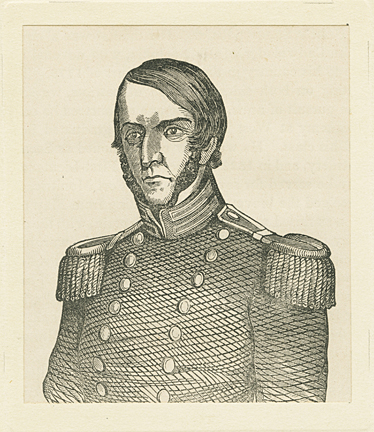
Brevet Major Samuel Ringgold was killed in the Battle of Palo Alto. Ringgold, Major Samuel, undated, MdHS, Small Prints.
Yet, the association sought to solidify the memory of the U.S-Mexican War through the construction of a monument. Monuments had gained increasing popularity in the United States prior to the Civil War. During the post-Civil War era, monuments became increasingly popular for commemorating the past as the nation struggled to create a new United States reunited after the Civil War.(20) Plans to erect a U.S.-Mexican War monument in Baltimore began in 1890. The association formed a twelve-man committee to raise funds. Led by Louis F. Beeler, Joshua Lynch, and James D. Iglehart, the committee lobbied city, state, and private contributors to cover the estimated $10,000 cost of the monument. The city appropriated $5,000 in July 1900. Meanwhile, the state appropriated an additional $3,000, which, with interest, rose to $3,600.(21)
The remaining balance for the monument came from private contributors. In seeking private donors, the association’s fundraising efforts sought to gloss over any dissent of the U.S.-Mexican War, focusing instead on the war’s overall benefits. One undated request informed potential subscribers that the successful completion of the U.S.-Mexican War “added so much valuable territory to the United States, wherein was found the gold and silver mines which [gave] our country its financial standing.” The request paid minor attention to the political dissent which surrounded the war, not even providing the reasons for political dissent.(22) As a result, the association received contributions from people like Edwin Warfield, president of the Fidelity and Deposit Company of Maryland. The association also received an additional $800 in private contributions, which covered the costs associated with changing the monument’s location from the triangular intersection of Liberty and Fayette Streets and Park Avenue to the intersection of Lanvale Street and Mount Royal Avenue.(23)
The political undertones in the request for subscriptions connected the Watson Monument to U.S. foreign policy during late-nineteenth and early-twentieth centuries. Given U.S. activity in the Caribbean, and the monument’s connection to the U.S.-Mexican War, the memorial presented a counterpoint to the overall anti-imperialist sentiment that existed in Baltimore during the period. Prominent Baltimore politicians like Senator Arthur Gorman refused to support the peace treaty with Spain unless it included an anti-expansionist amendment. Moreover, the Baltimore American expressed opposition to U.S. policy in the Caribbean, describing U.S. fighting in the Philippines as “our violent departure from the doctrine of the ‘consent of the governed.’”(24) The Watson Monument, on the other hand, offered a symbol of the U.S. mission to spread democracy to distant lands in order to uplift inferior peoples.
The Watson Monument provided the crowning achievement in the association’s efforts to memorialize the U.S.-Mexican War. With Watson standing tall, his sword resting peacefully at his side, the monument attested to the valor of Maryland’s U.S.-Mexican War veterans. The monument also attested to the sacrifice, with plaques containing the names of the Marylanders who died during the war.
However, the Watson Monument represents a political statement in favor of U.S. actions in Mexico and the Caribbean, highlighting the controversies surrounding U.S. policy. So the next time you are in West Baltimore and drive past the Watson Monument, or start humming “Maryland, my Maryland,” remember Watson and Ringgold, but also remember the history of Maryland’s complicated relationship with its nation’s southern neighbors. (Richard Hardesty and David Patrick McKenzie)
Richard Hardesty is a doctoral student at George Mason University in Fairfax, Virginia. In the summer of 2009, his article, “‘[A] veil of voodoo’: George P. Mahoney, Open Housing, and the 1966 Governor’s Race” appeared in the Maryland Historical Magazine. Richard previously contributed “Maryland Ahead by (Clarence) Miles,” which appeared on this blog on November 15, 2012. He is currently examining the role the Orioles played in the urban redevelopment of Baltimore.
David Patrick McKenzie is a doctoral student at George Mason University in Fairfax, Virginia, and a working public historian. He is studying the relationship between the United States and Latin America, particularly in the early 19th century. The views expressed here are his own and do not reflect those of any organization with which he is affiliated.
Footnotes:
1. We use the term “U.S.-Mexican War” in this post instead of the common “Mexican-American War” because the term “American” can refer to a person from North or South America. The war was solely between the United States and Mexico.
2. To Mexican War Heroes,” The Baltimore Sun, September 22, 1903; The Baltimore American, September 22, 1903.
3. Ibid.; “To Mexican War Heroes,” Baltimore Sun, September 22, 1903.
4. Baltimore American, September 22, 1903.
5. Historian Jacques Le Goff noted, “[m]emory, on which history draws and which it nourishes in return, seeks to save the past in order to serve the present and future.” Michael Kammen agreed, noting that critics of public memory complain about how societies use memory to manipulate the past in order to mold the present. Jacques Le Goff, History and Memory, trans. Steven Rendall and Elizabeth Claman (New York: Columbia University Press, 1992), 99; Michael Kammen, Mystic Chords of Memory: The Transformation of Tradition in American Culture (New York: Vintage Books, 1991), 3.
6. An excellent source on the complex chain of events leading to war is Richard Bruce Winders, Crisis in the Southwest (Wilmington, Del.: Scholarly Resources Books, 2002). Much of the context discussed in this section owes to Winders’s discussion of the war. Also, for background on Mexico’s perspective of the conflict, see Timothy J. Henderson, A Glorious Defeat: Mexico and Its War with the United States (New York: Hill and Wang, 2007).
7. J. Thomas Scharf, History of Maryland, vol. 3, 1812-1880 (Hatboro, Pennsylvania: Tradition Press, 1967), 221-2; John S. D. Eisenhower, So Far from God: The U.S. War with Mexico, 1846-1848 (Norman, Oklahoma: University of Oklahoma Press, 2000), 80.
8. Robert W. Johannsen, To the Halls of the Montezumas: The Mexican War in the American Imagination (New York: Oxford University Press, 1985), 124; “The Late Major Ringgold,” Baltimore Sun, May 28, 1846.
9. Scharf, History of Maryland, vol. 3, 221-2, 227; John R. Kenly, Memoirs of a Maryland Volunteer (Philadelphia: J.B. Lippincott & Company, 1873), 115, Eisenhower, So Far from God, 77-80; Charles J. Wells, Maryland and District of Columbia Volunteers in the Mexican War (Westminster, Maryland: Family Line Publications, 1991), 6.
10. Johannsen, Halls of the Montezumas, 85.
11. Other Marylanders died during the Battle of Monterey. For instance, Sergeant George A. Herring, of Baltimore, also fell during the attack on the Tannery. When Sergeant John Axer tended to him, Herring gasped, “go on boys you can not do any thing for me & when you get to Baltimore tell them I Died game.” Captain Randolph Ridgely survived the battle, but died in the battle’s aftermath. In Monterey, the streets had been made with basaltic rocks, of which many made up barricades in hopes of slowing up the U.S. advance. During a horse ride, Ridgely’s horse stumbled upon a basaltic rock, throwing Ridgley off in the process. When he landed, his head struck a sharp corner of another basaltic rock. Kenly, who had been with Ridgely thirty minutes prior to his accident, stated with shock that he “had parted with him not an half-hour previously, in the full enjoyment of life, health, and strength, and now I could not realize that though living he was unconscious.” John Axer to an unidentified recipient, October 2, 1846, Special Collections (Baltimore: Maryland Historical Society), MS 1507; Wells, Maryland and District of Columbia Volunteers in the Mexican War, 5; Kenly, Memoirs of a Maryland Volunteer, 160-3; Johannsen, Halls of the Montezumas, 85.
12. Senator James A. Pearce, Speech of Mr. Pearce, of Maryland, on the Ten Regiment Bill, delivered in the Senate of the United States [January 13, 1848] (Washington, D.C.: John T. Towers, 1848), 15, Special Collections (Baltimore: Maryland Historical Society), PAM 1814.
13. For a good summary of the treaty negotiations, see Daniel Walker Howe, What Hath God Wrought: The Transformation of the United States, 1815-1848 (New York: Oxford University Press, 2007), 800-811.
14. For more on the impact of the war on the United States, see Howe, 792-836.
15. Johannsen, Halls of the Montezumas, 108, 130.
16. Ibid.
17. The phrase came from Philippians 1:21-23 in the Bible, but the phrase also starts off Reverend Henry V. D. Johns’ sermon of Lieutenant Colonel Watson. Henry V. D. Johns, D. D., A Sermon Preached on Sunday, January 19, 1847 at the Request of Gratitude Lodge, No. 5, I.O.O.F as a Tribute of Respect to the Memory of Three of Their Members, W.H. Watson, G.A. Herring and J. Wilker Who Fell in the Mexican War (Baltimore: The Lodge, 1847), 7-8, Special Collections (Baltimore: Maryland Historical Society), MP 3.J46S 1847.
18. According to the Constitution’s fifth by-law, “The President shall have power to fine any member for misconduct during the meetings or parades of this Association, and command members misbehaving immediately to leave the room or ranks during parade or muster — such fine not to exceed one dollar for any one breach of conduct — and should any member of this Association misbehave himself, or be guilty of improper conduct, either in this Association or any other place, he shall be expelled from this Association upon a two-third vote of all the members present at any regular meeting hereof.” Constitution and By-Laws of the Association of Maryland Volunteers in the Mexican War, by-law 1st, Special Collections, MdHS, Baltimore; Constitution and By-Laws of the Association of Maryland Volunteers in the Mexican War, by-law 5th,, Special Collections, MdHS.
19. John R. Kenly, Papers, Special Collections (Baltimore: MdHS), MS 507, Box 1.
20. During the early-nineteenth century, the Bunker Hill monument gained national popularity, prompting the Chief Justice of Rhode Island to comment, “O! let us build monuments to the past.” The Civil War further fueled the popularity of monuments. For instance, the popularity of monuments was closely associated with the Lost Cause ideology. The majority of Lost Cause monuments had been initially erected in cemeteries, following the belief that “‘a memorial of a lost cause’ should ‘not be a triumphal memorial. Placed in the City of the Dead, and near the entrance, the sight of it cannot fail to call back the memory of the sad history which it commemorates.’” According to historian Gaines Foster, from 1865 to 1885, seventy percent of southern monuments had been erected in cemeteries. Public monuments also enjoyed popularity in the North after the Civil War. To illustrate, David McConaughy, head of the Gettysburg Battlefield Memorial Association (GBMC), understood that battlefield memories sacralized the landscape while also drawing visitors. By 1895, the GBMC had supervised the placement of 320 monuments. Kammen, Mystic Chords of Memory: The Transformation of Tradition in American Culture, 69, 71; Gaines M. Foster, Ghosts of the Confederacy: Defeat, the Lost Cause, and the Emergence of the New South (New York: Oxford University Press, 1987), 40-1; Jim Weeks, Gettysburg: Memory, Market, and an American Shrine (Princeton: Princeton University Press, 2003), 20, 60-1.
21. The Baltimore American article noted that, if the City Council appropriated $5,000.00 for the monument, “it will not be difficult to increase the total to $10,000 or $12,000, with which a fitting monument could be erected.” “Request for Contribution,” James D. Iglehart Papers, Special Collections (Baltimore: MdHS), MS 2384, Box 1; “Veterans of the Mexican War,” Baltimore American, July 1, 1900; “Lieut. Col. William H. Watson,” Baltimore Sun, 12 August 1902.
22. “Request subscriptions from the citizens of Baltimore,” James D. Iglehart Papers, Special Collections, MdHS, MS 2384, Box 1.
23. Edwin Warfield to James D. Iglehart, February 26, 1902, James D. Iglehart Papers, Special Collections, MS 2384, Box 1; “Request subscriptions from the citizens of Baltimore,” James D. Iglehart Papers, Special Collections, MdHS, MS 2384, Box 1.
24. “Still Fighting for Their Country,” Baltimore American, February 6, 1899; “The Vote on the Treaty,” Baltimore American, February 6, 1899.
Further reading:


